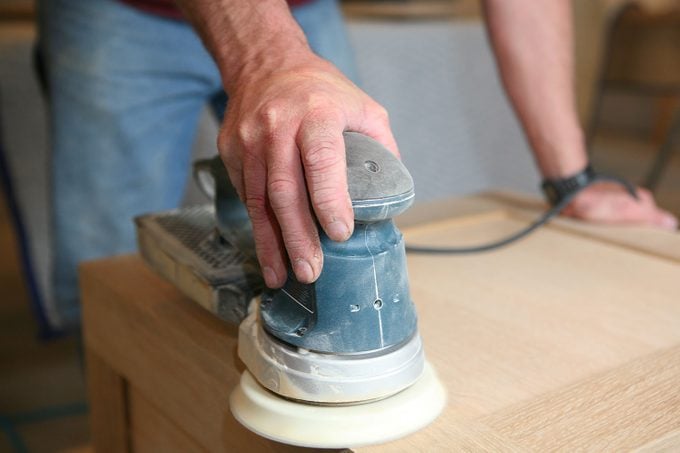If it wasn’t possible to spray paint wood, I might have spent several years of my life unemployed, because that was my main job from my late-20s to mid-30s. During that time I worked at two furniture finishing companies before I ran my own spray booth operation.
So if you’re asking, “Can you spray paint wood?” the answer is a definite yes. But should you? That’s another story altogether.
While it’s almost always better to spray paint on wood than brush it on, a lot can go wrong. You can mix the paint too thin or too thick, resulting in drips or splotches. You can paint things you didn’t intend to paint, including yourself. And, depending on the paint and whether you protect yourself properly, you could inhale toxic fumes.
There’s also the issue of equipment. If you’re painting a small piece like a chair or small cabinet, aerosol cans work well. But if you’re painting large pieces or exterior woodwork, or doing production work, you’ll need to buy or rent a sprayer and keep it clean. You’ll also need masking supplies, dropcloths, protective clothing and personal protective equipment (PPE).
It’s all worth it if you’re after a top-notch paint job, and you may even save time on large jobs. It’s up to you to decide whether doing the job with a paint brush and roller might be more practical.
Considerations for Spray Painting Wood
Spray-painting projects aren’t all the same. Some call for controlled conditions like a spray booth, and some call for a particular type of sprayer.
Here are some of the main things to think about if you’re considering spray painting wood:
Type of sprayer
If you’re painting furniture, you’ll get best results with a fast-drying lacquer or enamel, and many are solvent based.
The best choice for these materials is a high-volume, low-pressure (HVLP) sprayer, which requires an air compressor. If you’re painting wood interior or exterior walls or woodwork with water-based latex paint, an airless sprayer that pumps paint at high pressure is a better call.
Consider a handheld airless sprayer. These offer a reasonable compromise between air sprayers and high-volume airless ones house painters use. They can spray pretty much any material. But the flow is more difficult to control, so they aren’t the best choice for a high-quality furniture finish.
Temperature and humidity
High-humidity and low-temperature conditions cause fast-drying furniture lacquers and enamels to retain moisture and turn cloudy, a condition called blushing. Latex paint dries more slowly in these conditions, and it may drip if you spray it in thick coats. High temperatures and low humidity are better for spraying.
Mixing
When you use a brush and roller, you can apply paint straight out of the can. But you usually need to thin paint before spraying, especially when using an HVLP sprayer.
You need to know which type of thinner to use and mix it in the right proportion. Because you often determine the proportion by trial and error, you need a test surface to practice on say. a piece of cardboard or plywood.
Overspray and fumes
Solvent-based furniture finishes are high in volatile organic compounds (VOCs), so you need to keep the room where you’re working well ventilated and wear a respirator, not just a dust mask.
Overspray isn’t a huge issue with these paints. Fast-drying finishes atomize when shot from an HVLP sprayer, and the material that doesn’t hit the spot you’re aiming for usually turns to dust.
Latex paint shot from an airless sprayer also creates fumes, although they aren’t quite as toxic. The overspray remains in liquid form and will stick to anything in the vicinity you haven’t covered.
Prepping Wood for Spraying

By itself, spraying goes quickly, but masking surrounding surfaces can be time-consuming. You’ll also need protective clothing, especially when spraying latex paint, which can get messy.
When spraying outdoors, be mindful of surrounding plants and walkways and be sure to cover them. The last thing you need is a rose bush that’s the same color as your house.
Before spraying any type of wood, make sure it’s clean and mold-free, and its finish is in good shape and won’t peel. Otherwise, you’ll need to strip the finish before spraying.
Sanding is a necessary prerequisite to spraying furniture or interior woodwork. The amount of sanding and the sandpaper grit you use depends on the quality of finish you’re after. Sanding to 120-grit is usually sufficient for shelves and woodwork. For tables, cabinets and other quality woodwork, it’s better to sand to 150- or even 220-grit.
Sealing Bare Wood
To get the quality of finish spraying makes possible, you’ll need to seal bare wood before adding topcoats.
For interior woodwork or furniture, a lacquer-based sanding sealer is best, because it contains soaps that make it easy to sand smooth. If you’re going to apply latex paint with an airless sprayer, a shellac-based primer provides the best undercoat, but water-based ones are also OK.
You’ll get the best furniture finish by spraying multiple coats and scuff-sanding between coats with 220-grit sandpaper. Solvent-based interior finishes dry quickly, so you can usually spray several coats in a single afternoon.
Article source here: Can You Spray Paint Wood?


No comments:
Post a Comment